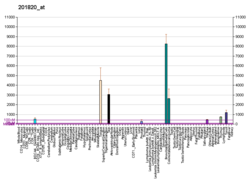This article is about the protein. For the album, see
CK5 .
KRT5 Identifiers Aliases KRT5 External IDs OMIM : 148040 ; MGI : 96702 ; HomoloGene : 55461 ; GeneCards : KRT5 ; OMA :KRT5 - orthologs Wikidata
Keratin 5 , also known as KRT5 , K5 , or CK5 , is a protein that is encoded in humans by the KRT5 gene .[ 5] [ 6] [ 7] dimerizes with keratin 14 and forms the intermediate filaments (IF) that make up the cytoskeleton of basal epithelial cells .[ 8] [ 9] epidermolysis bullosa simplex and breast and lung cancers.[ 9] [ 10] [ 11]
^ a b c GRCh38: Ensembl release 89: ENSG00000186081 – Ensembl , May 2017^ a b c GRCm38: Ensembl release 89: ENSMUSG00000061527 – Ensembl , May 2017^ "Human PubMed Reference:" . National Center for Biotechnology Information, U.S. National Library of Medicine .^ "Mouse PubMed Reference:" . National Center for Biotechnology Information, U.S. National Library of Medicine .^ "Entrez Gene: KRT5 keratin 5 (epidermolysis bullosa simplex, Dowling-Meara/Kobner/Weber-Cockayne types)" .^ Lersch R, Fuchs E (Jan 1988). "Sequence and expression of a type II keratin, K5, in human epidermal cells" . Molecular and Cellular Biology . 8 (1): 486–93. doi :10.1128/mcb.8.1.486 . PMC 363157 PMID 2447486 . ^ Eckert RL, Rorke EA (Jun 1988). "The sequence of the human epidermal 58-kD (#5) type II keratin reveals an absence of 5' upstream sequence conservation between coexpressed epidermal keratins". DNA . 7 (5): 337–45. doi :10.1089/dna.1.1988.7.337 . PMID 2456903 . ^ Chan YM, Yu QC, LeBlanc-Straceski J, Christiano A, Pulkkinen L, Kucherlapati RS, Uitto J, Fuchs E (Apr 1994). "Mutations in the non-helical linker segment L1-2 of keratin 5 in patients with Weber-Cockayne epidermolysis bullosa simplex". Journal of Cell Science . 107 (4): 765–74. doi :10.1242/jcs.107.4.765 . PMID 7520042 . ^ a b Atkinson SD, McGilligan VE, Liao H, Szeverenyi I, Smith FJ, Moore CB, McLean WH (Oct 2011). "Development of allele-specific therapeutic siRNA for keratin 5 mutations in epidermolysis bullosa simplex" . The Journal of Investigative Dermatology . 131 (10): 2079–86. doi :10.1038/jid.2011.169 PMID 21716320 . ^ Mulvihill MS, Kratz JR, Pham P, Jablons DM, He B (Feb 2013). "The role of stem cells in airway repair: implications for the origins of lung cancer" . Chinese Journal of Cancer . 32 (2): 71–4. doi :10.5732/cjc.012.10097 (inactive 2024-04-03). PMC 3845611 PMID 23114089 . {{cite journal }}: CS1 maint: DOI inactive as of April 2024 (link )^ van de Rijn M, Perou CM, Tibshirani R, Haas P, Kallioniemi O, Kononen J, Torhorst J, Sauter G, Zuber M, Köchli OR, Mross F, Dieterich H, Seitz R, Ross D, Botstein D, Brown P (Dec 2002). "Expression of cytokeratins 17 and 5 identifies a group of breast carcinomas with poor clinical outcome" . The American Journal of Pathology . 161 (6): 1991–1996. doi :10.1016/S0002-9440(10)64476-8 . PMC 1850928 PMID 12466114 . 



